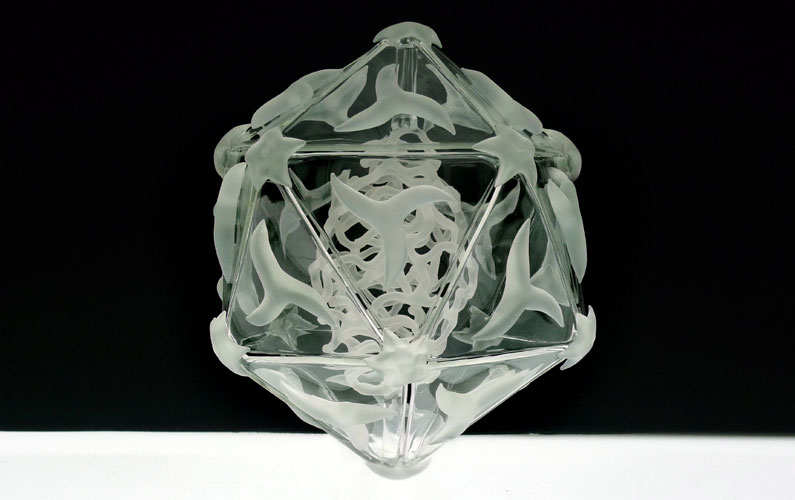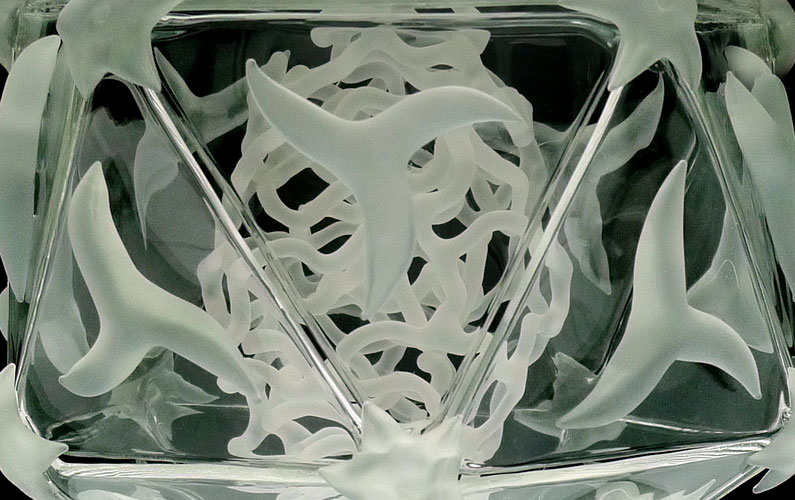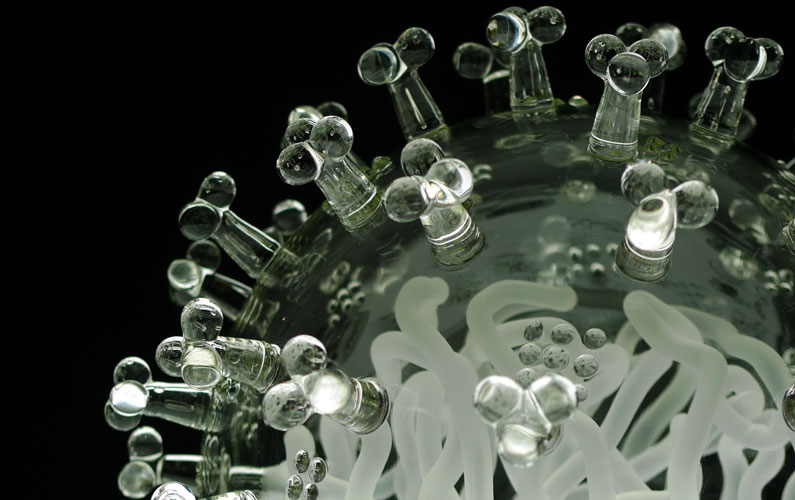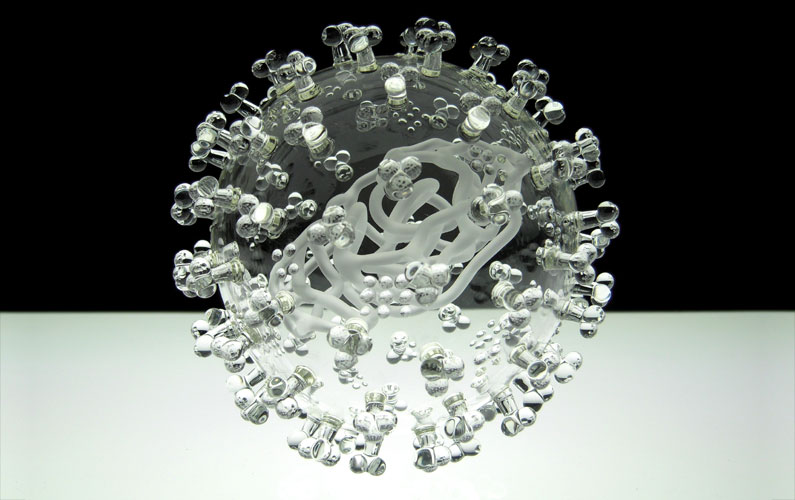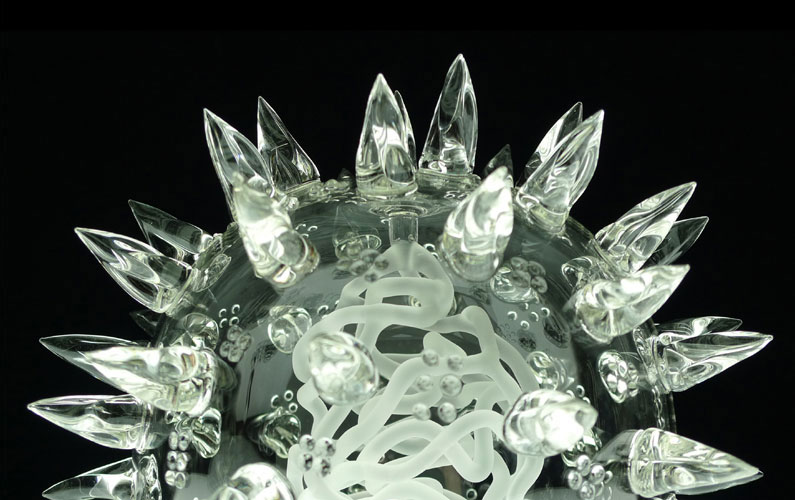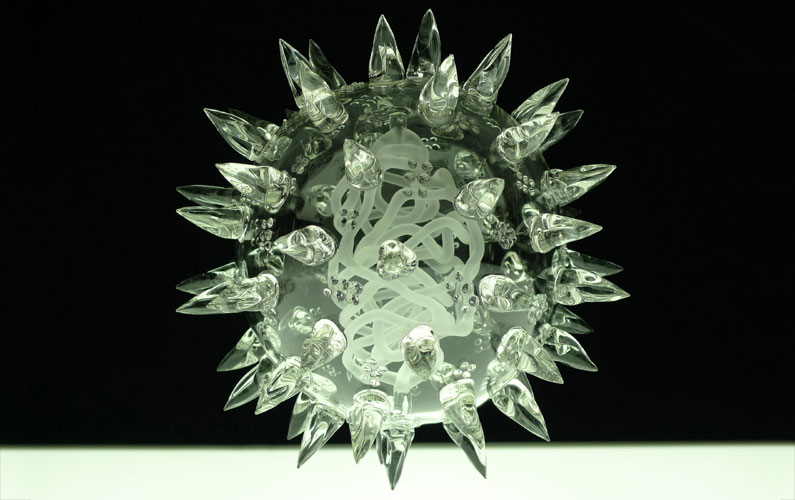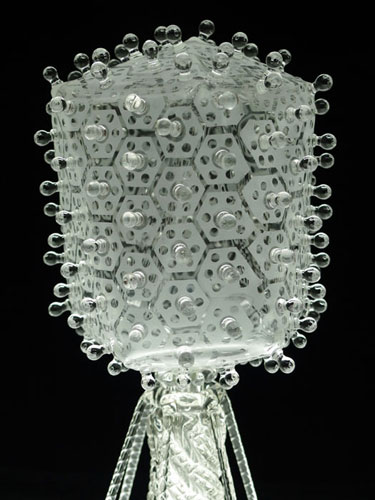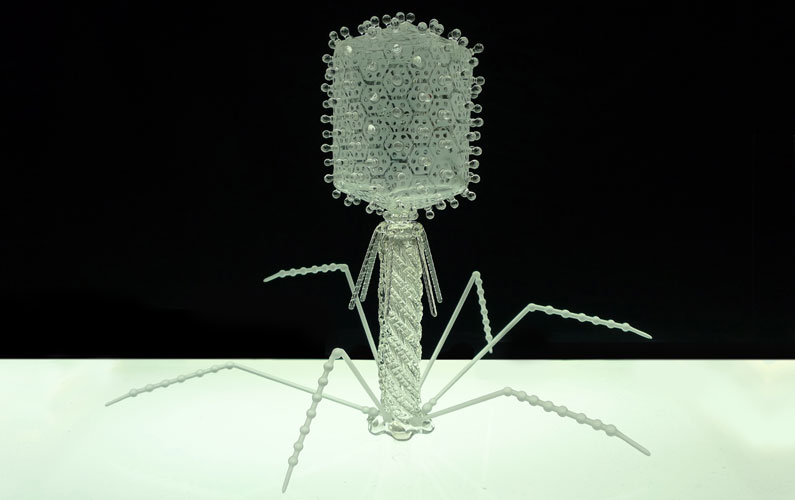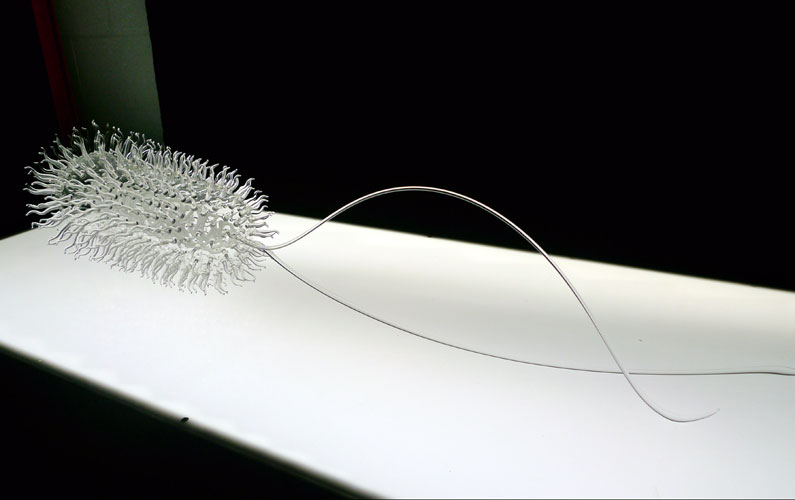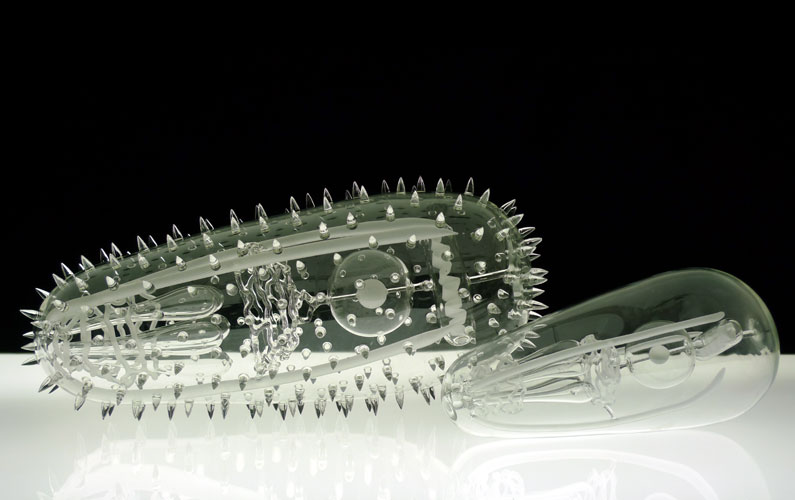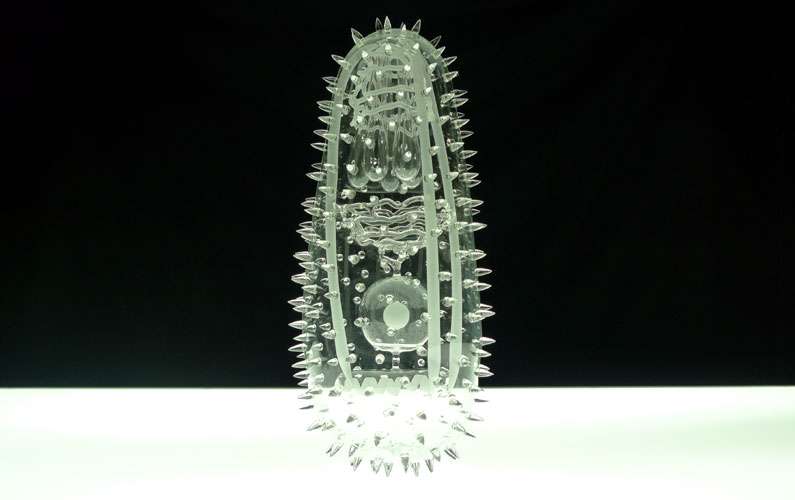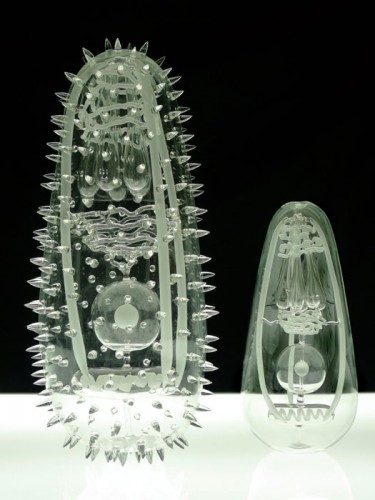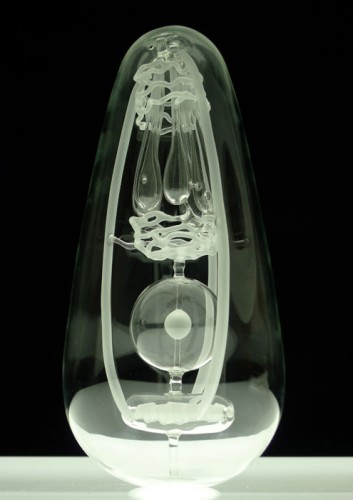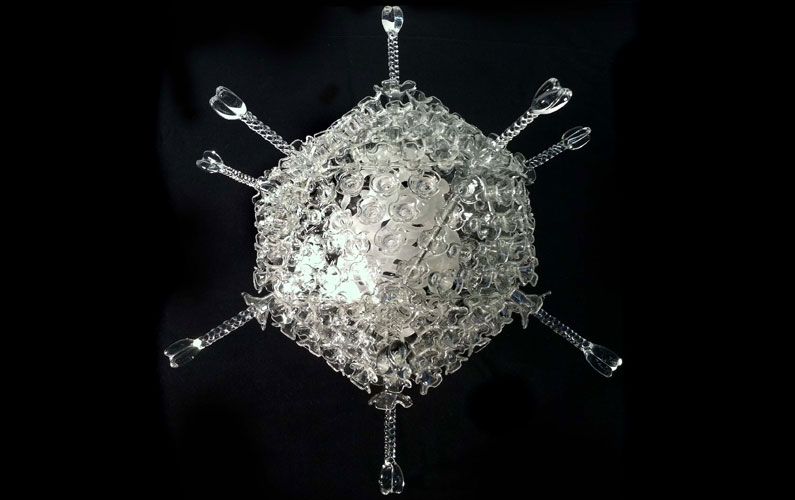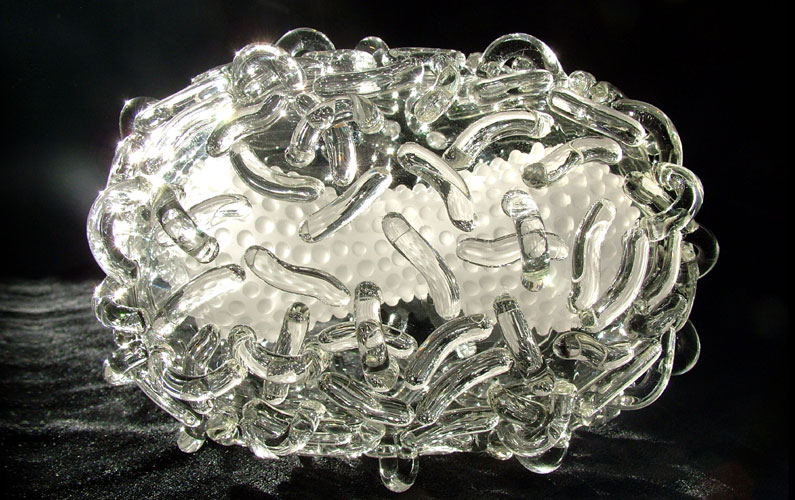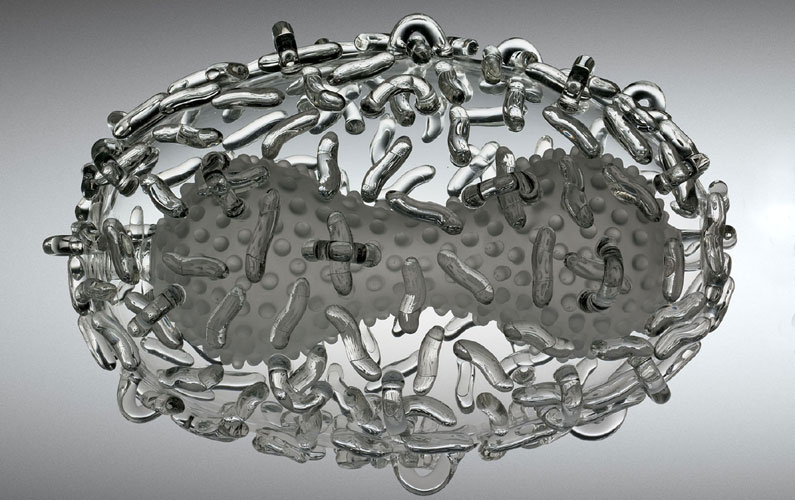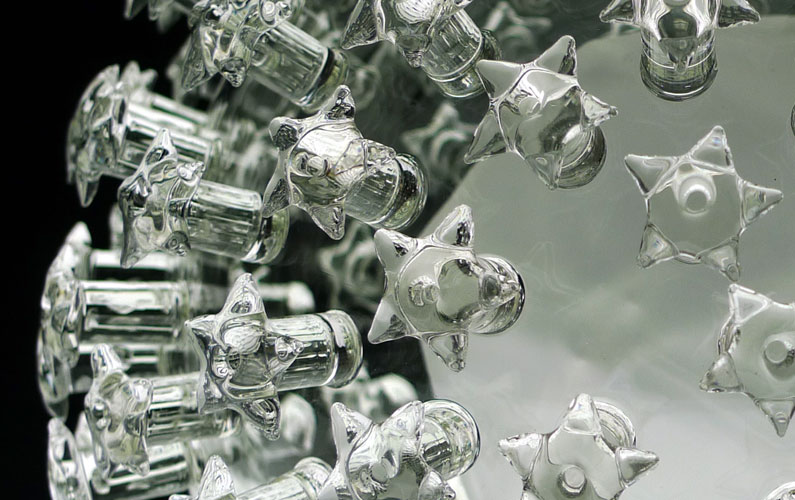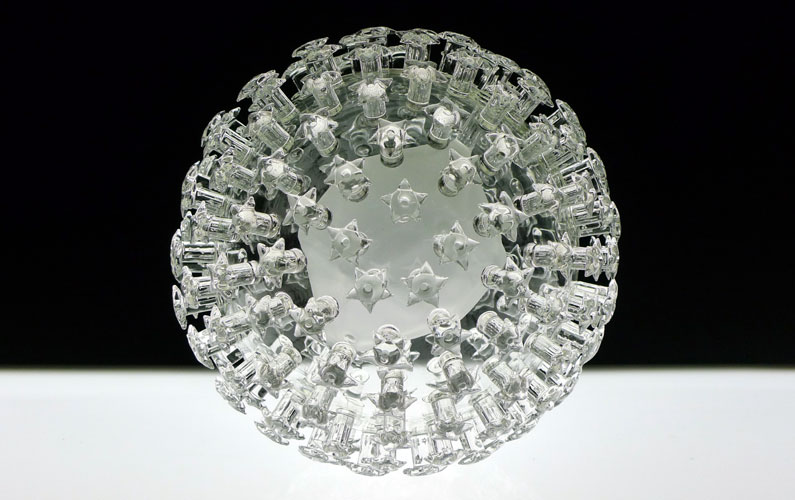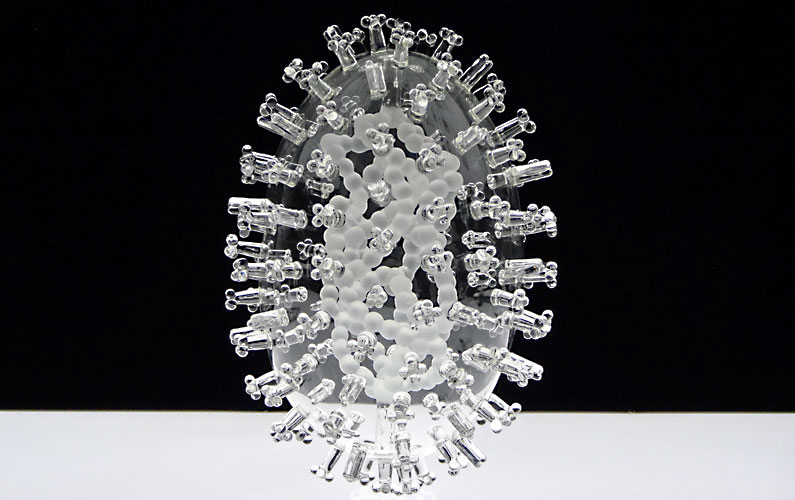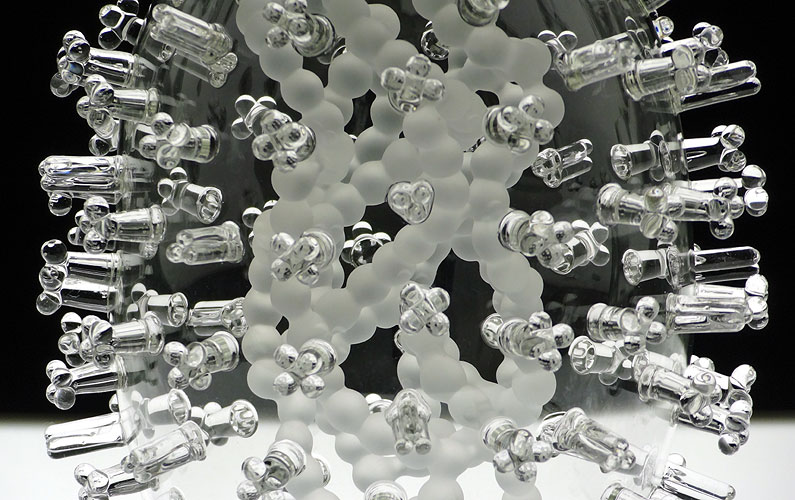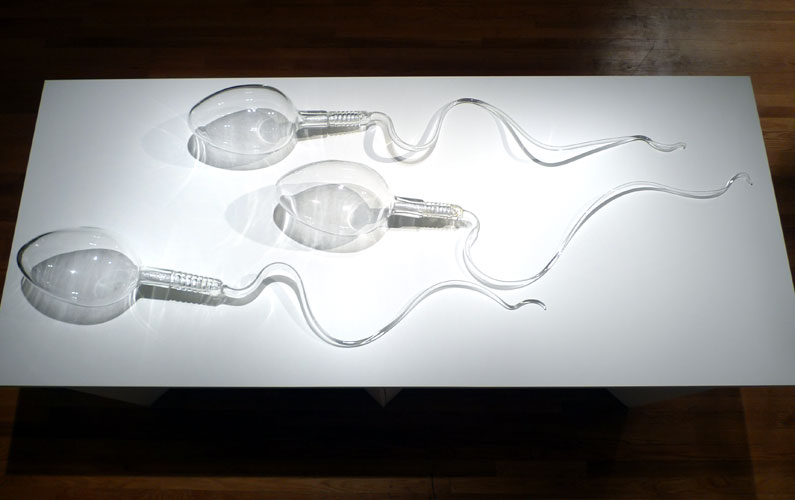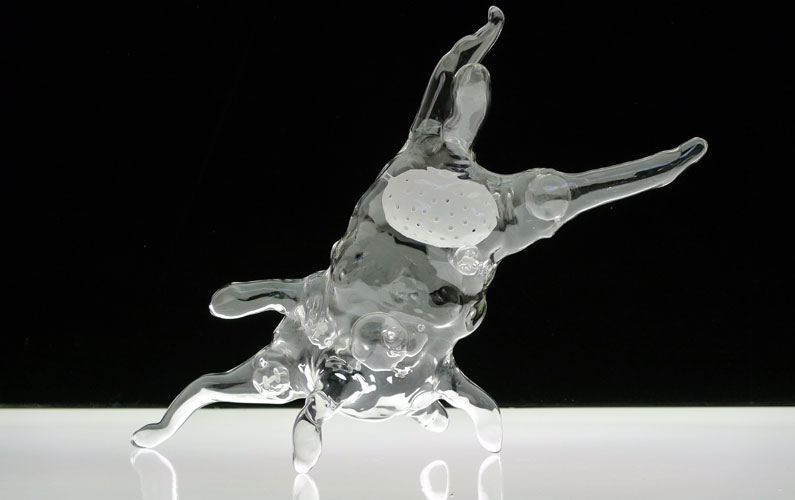Glass Microbiology by Luke Jerram
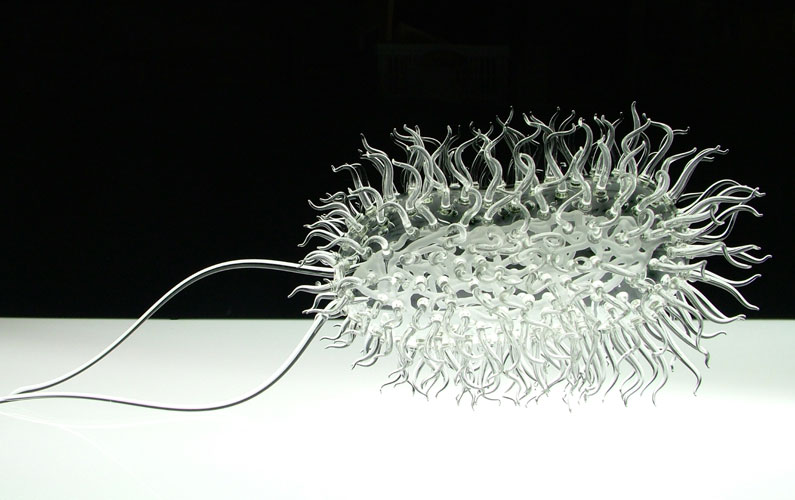
Created in clear glass, the sculptures are designed for contemplation and to consider how the artificial colouring of scientific imagery affects our understanding of phenomenon.
Artist Luke Jerram
Luke Jerram has created a number of extraordinary art projects which have excited and inspired people around the globe. Based in the UK, Luke Jerram’s practice involves the creation of sculptures, installations, live arts projects and gifts. Further information on Luke’s entire practice can be found here: www.lukejerram.com.
About the Glasswork
This body of glass work has been developed since 2004. Made to contemplate the global impact of each disease, the artworks were created as alternative representations of viruses to the artificially coloured imagery we receive through the media. In fact, viruses have no colour as they are smaller than the wavelength of light. By extracting the colour from the imagery and creating jewel like beautiful sculptures in glass, a complex tension has arisen between the artworks’ beauty and what they represent.
His transparent and colourless glassworks consider how the artificial colouring of scientific microbiological imagery, affects our understanding of these phenomena. See these examples of HIV imagery. If some images are coloured for scientific purposes, and others altered simply for aesthetic reasons, how can a viewer tell the difference? How many people believe viruses are brightly coloured? Are there any colour conventions and what kind of ‘presence’ do pseudocoloured images have that ‘naturally’ coloured specimens don’t? How does the choice of different colours affect their reception?
Photographs of Jerram’s glass artworks are now used widely in medical journals, text books and media stories and are seen as useful representations of virology within the scientific community. In 2009 his work was used in the Lancet, the British Medical Journal and on the front cover of Nature Magazine.
The sculptures are designed in consultation with virologists from the University of Bristol, using a combination of different scientific photographs and models. They are made in collaboration with glassblowers Kim George, Brian Jones and Norman Veitch.
Limited Editions
Jerram’s glass artworks are for sale to private collectors and public museums. Artworks are signed and dated, limited editions of just 5. As such, new works can sell out quickly.
Ev71 – Hand Foot and Mouth Disease
Enterovirus 71 (EV71), one of the major causative agents for hand, foot and mouth disease (HFMD)
This virus is a member of the enterovirus species A. This virus appears to have evolved only recently with the first known strain was isolated in 1965. It was associated with an outbreak of neurological disease in the United States in 1969.
The artwork was commissioned by a scientific research center in 2012. An edition of this work is in the permanent collection of the Wellcome Trust in London.
Swine Flu (spherical)
The 2009 flu pandemic was an outbreak of a new strain of H1N1 influenza virus, usually referred to as “swine flu“. First described in April 2009, the virus appeared to be a new strain of H1N1 which resulted when a previous triple re-assortment of bird, swine and human flu viruses further combined with a Eurasian pig flu virus.[3] Unlike most strains of influenza, H1N1 does not disproportionately infect adults older than 60 years; this was an unusual and characteristic feature of the H1N1 pandemic.
In an interview with the Wellcome Collection Jerram said.. “At the beginning of the outbreak I was diagnosed with swine flu. It was strange designing the sculpture with a fever whilst swalling my Tamiflu tablets every few hours. I remember there was a lot of confusion as to whether the virus was going to wipe out a third of the global population. There were lots of different scientific imagery and diagrams flying around in the media. The reason I made the Swine Flu sculpture is because people care about it. What I’m doing is providing an alternative representation of the virus for the public to consider.”
Untitled Future Mutation
This is a fictional virus, a future virus that has yet to be born. Has this virus been created in the laboratory or evolved naturally? Will the impact of this virus be of benefit or hinderance to humanity?
The common public perception is that the only function of viruses is to cause disease. But research has now found a substantial amount of evidence that they serve several major roles in ecology and are actually essential for life. Without viruses, the genetic revolution we are now experiencing would be impossible. They also serve numerous beneficial functions that we are just beginning to research and understand.
T4 Bacteriophage
This artwork has been created to be exhibited at the 2011 Venice Biennale in Glasstress 2011. It’s the most detailed and intricate glasswork Jerram and his team have made to date.
The virus infects E. coli bacteria and has been used for over 60 years in the former Soviet Union and Eastern Europe as an alternative to antibiotics. More recently, the virus has been seen to have potential as a therapy against multi drug resistant strains of many bacteria. One potential treatment currently under development is a phage designed to destroy MRSA.
E. coli
This is one of the largest and most fragile of Jerram’s sculptures. Recently exhibtions of this work include the Museum of Art and Design – NYC, Glasstress – Venice, Oklahoma City Museum, Cosmo Caixa Museum – Barcelona.
Read about in the Huffington Post.
Escherichia coli, commonly abbreviated E. coli, is a Gram-negative rod-shaped bacterium that is commonly found in the lower intestine of warm-blooded organisms (endotherms). Most E. coli strains are harmless, but some, such as serotype O157:H7, can cause serious food poisoning in humans, and are occasionally responsible for product recalls. The harmless strains are part of the normal flora of the gut, and can benefit their hosts by producing vitamin K2, and by preventing the establishment of pathogenic bacteria within the intestine.
Malaria
These sculptures respresent the Malaria parasite (Plasmodium falciparum Merozoite). The smooth model shows the parasite just after it has entered a red blood cell. The spike malaria shows the Plasmodium before. See here for more information about the life cycle of Malaria.
The artwork is about 200,000 X larger than the actual parasite.
HIV
The sculptures of HIV were made as objects to hold, to contemplate the impact of the disease upon humanity.
The artworks were also created to consider how the use of artificially added colour in medical imaging effects how the imagery is read and interpreted by the public. See these examples of scientific HIV imagery. How does the choice of different colours affect their reception? In response to these questions, Jerram has created a series of transparent, three dimensional sculptures of HIV. Ironically in 2007 photographer David Sayer won an award from the Institute of Medical Imaging for the artificially coloured image (above) he took of Jerrams HIV sculpture. With thanks to the Wellcome Collection for use of the imagery.
A letter from a stranger received Sept ’09 about the HIV artworks……
Dear Luke,
I just saw a photo of your glass sculpture of HIV.
I can’t stop looking at it. Knowing that millions of those guys are in me, and will be a part of me for the rest of my life. Your sculpture, even as a photo, has made HIV much more real for me than any photo or illustration I’ve ever seen. It’s a very odd feeling seeing my enemy, and the eventual likely cause of my death, and finding it so beautiful.
Thankyou.
Adenovirus – Common Cold
Adenoviruses are a group of viruses that cause respiratory (breathing) illnesses, such as a common cold, conjunctivitis (an infection in the eye), croup and bronchitis.
They are common and highly contagious. Most adenovirus infections are mild.
Smallpox
Of all human infectious diseases, smallpox is believed to have resulted in more human deaths throughout history than from any other single pathogen. The causative agent of smallpox, Variola virus, was eradicated from natural existence in 1977, through a global vaccination effort administered by the World Health Organization (WHO). Currently, the only official stores of Variola are in freezers of two research sites: one at the Centers for Disease Control (CDC) in Atlanta, and one at the VECTOR research facility in Russia. Should these samples be kept for future scientific research? Or should they be destroyed as the samples are too dangerous to keep? Jerram’s sculpture was used on the front cover of a book debating these issues.
SARS Corona Virus
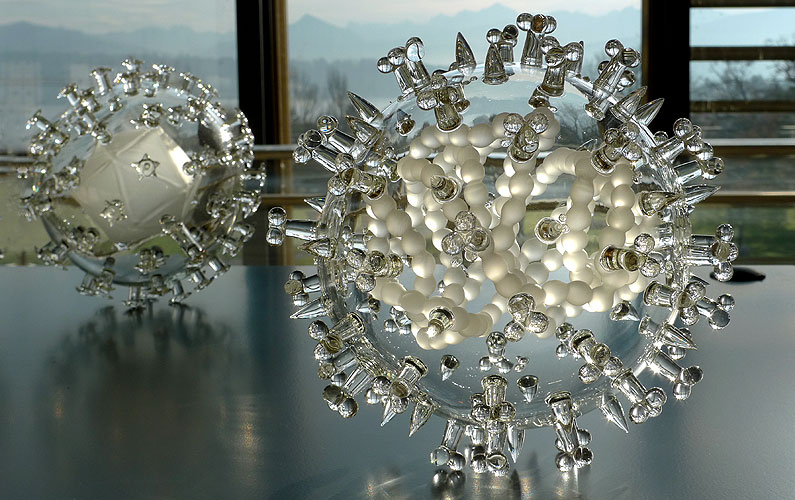
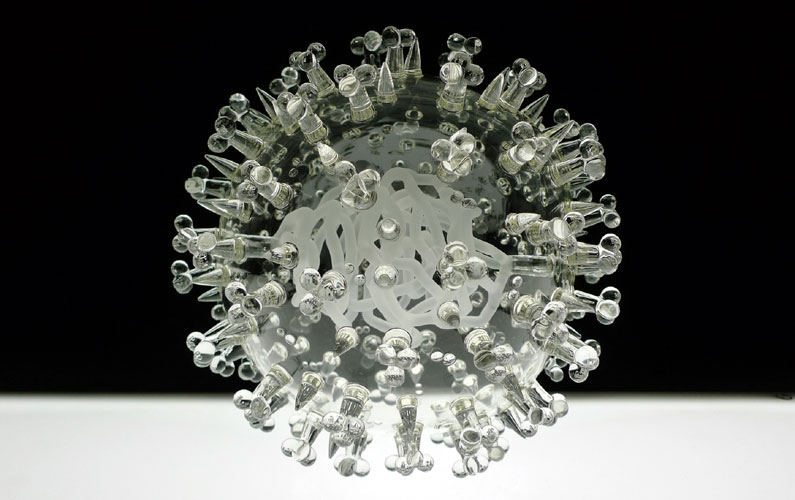
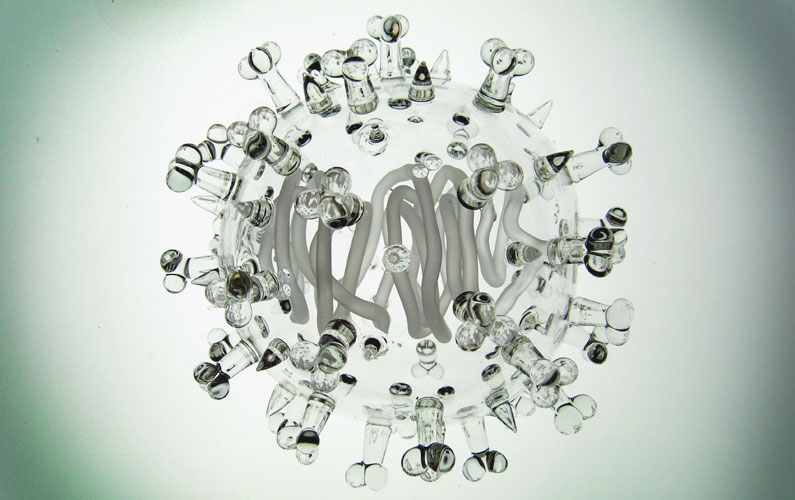
Severe acute respiratory syndrome (SARS) is a serious form of pneumonia, caused by a virus isolated in 2003. Infection with the SARS virus results in acute respiratory distress (severe breathing difficulty) and sometimes death. It is a dramatic example of how quickly world travel can spread a disease. It is also an example of how quickly a networked health system can respond to an emerging threat. This work has recently been displayed at the UN in Geneva for the Conference of Non Proliferation of Biological Weapons!
Human Papillomavirus
Human papillomavirus (HPV) is a member of the papillomavirus family of viruses that is capable of infecting humans. Like all papillomaviruses, HPVs establish productive infections only in the stratified epithelium of the skin or mucous membranes.
Avian flu (H5N1)
Avian Influenza, commonly known as Bird Flu, refers to “influenza caused by viruses adapted to birds”.
Spermatazoa
A spermatozoon (plural spermatozoa) is a motile sperm cell, or moving form of the haploid cell that is the male gamete. The termspermatozoon comes from the Greek word σπέρμα (seed) and ζῷον (living being).
Ameoba
Amoeba is a genus of Protozoa consisting of shapeless unicellular organisms. Standing 30cm x 40cm the glass sculpture contains all the details of the Ameoba. A description of the Ameoba is here.
More…
A Sense of Scale
The virus sculptures are approximately 1,000,000 times larger than the actual viruses. This great slide bar animation shows how small they really are.
Collections and Awards
Jerram’s Glass Microbiology sculptures are in Museum collections around the world from The Corning Museum in NYC to the Wellcome Collection in London. In 2009, his sculptures were presented at The Mori Museum, Tokyo along with work by Damien Hirst, Warhol and Leonardo da Vinci.
In 2010, he was awarded the coveted ‘Rakow Glass Award’ for his work and in 2007 the ‘Institute for Medical Imaging Award’. Jerram has recently completed a fellowship at the Museum of Glass, Washington, USA. Awarded Europe’s largest arts award the NESTA Fellowship in 2002-2005, his first sculpture was created during this time.
Loans and Sales of Artwork
See latest Catalogue of works available for sale.
Works are for sale to private collectors and public museums. Artworks are signed and dated, limited editions of just 5. As such, new works can sell out quickly.
Collections of works can also be loaned from the artist for exhibitions. Contact info@lukejerram.com about purchasing and the loan of work. For sales in the USA, contact the Heller Gallery in NYC info@hellergallery.com

